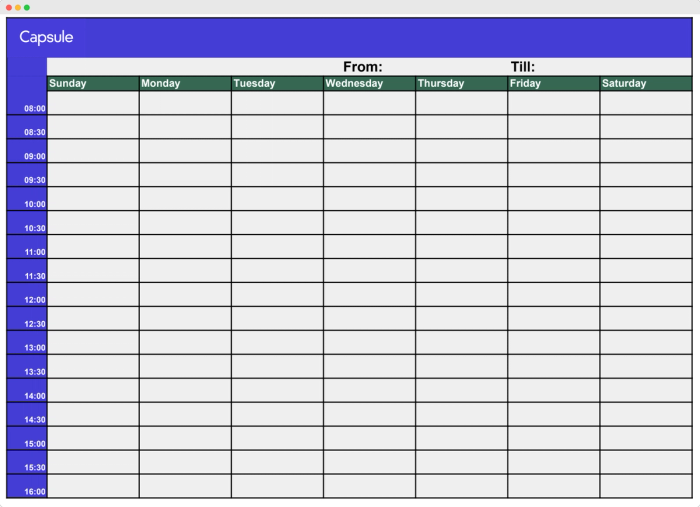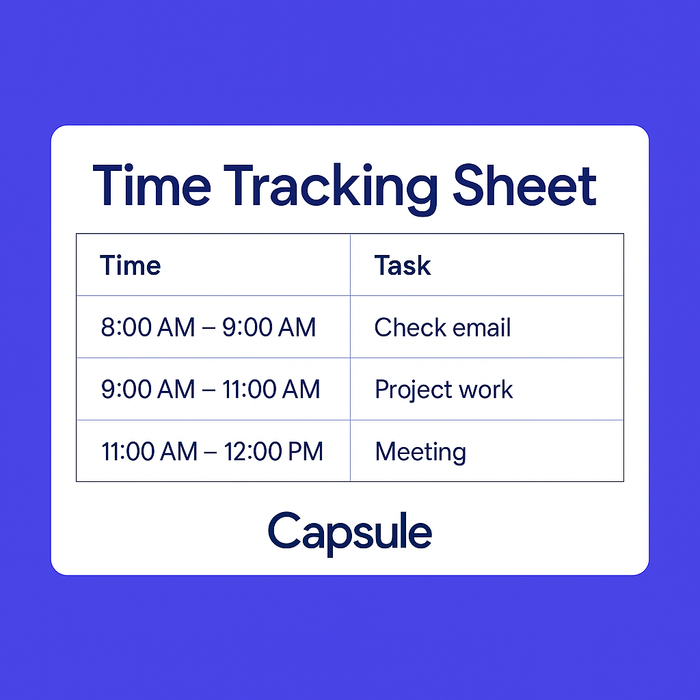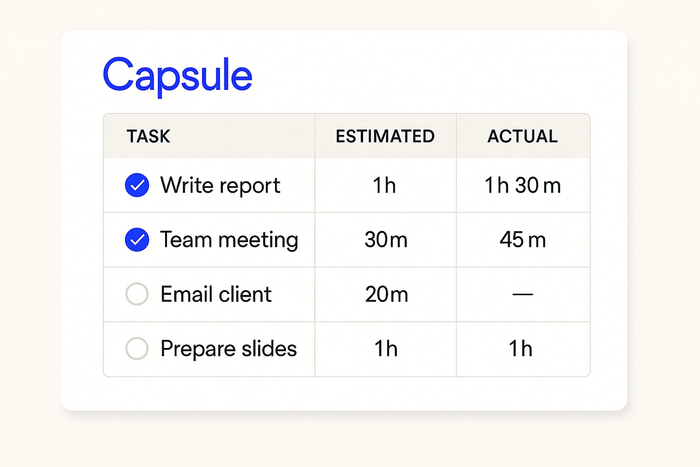Feel like you're always busy but never caught up?
You’re not alone. Most of us move from task to task without a clear picture of how our time gets spent. The result? Days blur together, important work doesn’t get done.
A simple timesheet could help you change that — if you use the right one.
In this guide, you’ll learn how time management sheets work, the different types you can try, and how to pick (or customize) one that fits your routine. There's a printable weekly sheet included too, along with step-by-step tips to help you stay on track.
Let’s find a way to make your time work for you — one sheet at a time.
What is a time management sheet?
A time management sheet is a simple tool for logging how you spend your day — hour by hour or task by task. It can be a printed planner, a spreadsheet, or a scribbled list. The goal is the same: to help you see where your time goes.
Time management sheets help you with:
- Catching time-wasting activities – You’ll spot sneaky habits like multitasking, context switching, or spending 45 minutes “checking one email.”
- Controlling your workflow – Tracking your time creates a feedback loop. You stop guessing and start deciding what gets your energy
- Building a better end to your day – With a clear plan, it’s easier to log off and actually stop working when the day’s done.
Some studies even show that people who track their time feel more in control. Makes sense. Once you know where the hours go, it’s easier to take charge of them.
Types of time management sheets
A time management “sheet” doesn’t have to be a sheet at all. It can be a list on a sticky note, a color-coded calendar, or even a scribble in your notebook during your morning coffee. What matters is that it helps you see your day clearly and make better decisions with your time.
Here are a few formats worth trying. Pick the one that fits your routine — or mix and match as your week unfolds.
1. Daily or weekly planner

This one’s for those who like to see their week before it starts. It’s structured like a calendar, with time slots for each day, so you can block out client calls, focus hours, team check-ins, or even your lunch break. It’s ideal if your brain works best with structure and your schedule changes often.
Unlike a time log or task list, this sheet helps you shape the day before it begins. It’s proactive, not reactive — perfect for avoiding last-minute chaos.
📌 Use it to: avoid double-booking yourself, protect time for deep work, and stop meetings from eating your day alive.
2. Time tracking sheet (or time log)

You sit down for the day, blink a few times, and somehow it's 5 p.m. Sounds familiar? A time log helps you trace your steps — not in your head, but on paper. You log what you did and when you did it during the day.
It’s the most revealing type of planner because it actually shows reality and not your intentions. Perfect if you're trying to get a handle on distractions and time sinks.
📌 Use it to: track tasks in real time, compare planned vs. actual hours, and spot invisible time drains before they become habits.
3. Task list with time estimates

Ever write a to-do list that looks feasible, and then realize you only had time for completing half of it? The task list format helps you gut-check your expectations. You jot down your tasks for the day, assign a time estimate to each one, and (optionally) track how long they really take.
It shifts your focus from just starting tasks to actually finishing them — without stacking your day like a game of calendar Tetris.
📌 Use it to: juggle multiple projects and avoid overcommitment
4. Priority matrix sheet

Staring at a long list of tasks and thinking, “Where do I even start?” That’s exactly what the priority matrix helps you fix. Also known as the Eisenhower Matrix, it’s a four-box grid that helps you sort your tasks by urgency and importance — so you spend less time reacting and more time deciding.
Here’s how it works:
- Important + Urgent – Do it now
- Important but Not Urgent – Schedule it
- Urgent but Not Important – Delegate it
- Neither – Drop it
You won’t block out time like with a planner, but this format gives you clarity before your day begins. It’s ideal when everything feels important, but your hours are limited.
📌 Use it to: make faster decisions, focus on what truly moves the needle, and stop letting urgent-but-meaningless tasks hijack your day.
How to use a time management sheet step by step
You don’t need a perfect system — just something simple you’ll actually use. With the right sheet and a few small habits, time tracking becomes less of a chore and more of a cheat code. Here’s how to make it a part of your workflow:
1. Decide how far ahead you’re planning
Some people plan each day the night before. Others map out their whole week in one go. There’s no right way — just what works for your brain and your schedule.
If you’re new to this, start small: plan your day each morning or right before logging off. Once it feels natural, you can start blocking time by the week or even month.
Practical examples:
- Sunday night reset – Sketch out your Monday, add key tasks, and leave space for anything that rolls in last-minute.
- Friday wrap-up – Use the last 15 minutes of your week to outline the next one — deadlines, team meetings, and anything you want off your mind for the weekend.
- Midweek check-in – On Wednesday, assess what’s left, reshuffle as needed, and plug in any new tasks for Thursday and Friday — with no backlog surprises.
2. Add your tasks
Here’s where your sheet stops being a blank page and starts pulling its weight.
Block time for what actually fills your day — calls, deep work, admin, even breaks. Use a planner with hourly slots or a task list with time estimates. Either way, break big tasks into bite-sized pieces so you can see progress (and avoid overwhelm).
Practical examples:
- Got “write blog post” on the list? Split it up: 9–10 a.m. for research, 10–11:30 for writing, 2–2:30 for edits
- Instead of “emails,” block two 20-minute windows — one mid-morning, one late afternoon — to avoid inbox spirals
- For client work, break down the workflow: e.g., 10–10:30 = prep brief, 10:30–11 = draft, 11–11:15 = send + log in CRM.
The goal: a flow that feels natural and leaves you with something to show at the end of the day.
3. Prioritize the most important work
Don’t let your day get hijacked by busywork. Before anything else, pick your top three tasks: the ones that actually move the needle. Highlight them, number them, star them... whatever makes them stand out.
You shouldn’t just do everything. You must ensure that the right things get done.
Practical examples:
- Got invoices piling up? Make that task #1 — and give it a protected time slot before anything else.
- Block off your best focus hour (say, 9–10 a.m.) for your highest-impact task — not Slack or email.
- Use a simple system: 🔴 Must do, 🟡 Nice to do, ⚪ Can wait — and stick to it.
When everything feels urgent, this step helps you remember what’s actually important.
4. Follow the plan, but be ready to adjust
You planned to spend the afternoon writing, but then a call ran over, your laptop needed a restart, and suddenly it’s 3 p.m. That’s life — and your time sheet should flex with it.
Treat your plan like a roadmap, not a contract. Shift things around, leave buffer zones, and don’t be afraid to bump a task to tomorrow on purpose.
Practical examples:
- If a tech issue eats up your 2–4 p.m. marketing slot, move the slot to tomorrow and add a note so nothing slips.
- Leave 15-minute cushions between big blocks — for snack breaks, spillover, or just breathing room.
- Reschedule low-priority tasks instead of cramming them in just to check a box.
5. Set up your sheet so you can actually stick with it
If it’s buried in a notebook or a closed browser tab, you won’t use it. Keep your planner where you’ll see it all day — on your desk, pinned to your wall, or open in a browser tab you never close.
Tip: If you’re printing your sheets, date them and keep a copy. It’ll make reviewing your progress easier later.
Also: build in breathing room. Back-to-back blocks might look productive, but they’ll collapse after one overrun meeting. Leave 15–30 minute buffers to reset or shift things around.
Practical examples:
- Leave space between deep work and calls to avoid mental whiplash.
- Print your sheet and keep it by your laptop — not in a drawer.
- Block off 10-minute micro-breaks right after heavy-focus blocks.
6. Reflect, adjust, and reward the effort
No system is perfect the first time around. Review your sheet weekly to catch patterns: which tasks took longer? What always gets postponed? Adjust your plan accordingly — move tricky tasks to a better time or drop what’s not working.
And when you do follow through? Give yourself a win: a walk, a snack, or even just writing down “finished everything by 4:30.” It builds momentum.
Practical examples:
- Friday recap: What worked this week? What didn’t?
- Always underestimate writing time? Give it more space next week.
- Keep a “small wins” section at the bottom of your sheet to remind yourself what went right.
Sample time management schedule template you can print now
Here’s a simple example of a weekly planner sheet template you can use right away. This one covers a full week, from Sunday to Saturday.

Grab the printable version here:👉 Capsule CRM | Time Management Sheet Template
Use this file if you want to:
- Build a consistent daily routine
- Map out class schedules or meeting blocks
- Spot patterns in how you use your work hours
- Set time limits to avoid going overtime
- Track how your tasks fill out the day and manage time efficiently
How to use this weekly planner
This sheet is built to help you plan your week and stay focused during work hours. It runs from Sunday to Saturday, with 30-minute time blocks from 8:00 a.m. to 4:00 p.m.
1. Fill in the date range
At the top of the sheet, next to “From” and “To,” write the start and end dates for the week you’re planning.
✏️ Example: From: April 8 – To: April 14
2. Add fixed events first
Start by filling in anything that won’t move – meetings, calls, appointments, or classes. Add them under the correct day and time.
✏️ Example: Monday, 10:00–11:00 = Client call
3. Block time for deep work
Pick a few quiet hours for tasks that need focus. Add one task per time block, and try not to overload each day.
✏️ Example: Tuesday, 9:00–10:30 = Marketing report
4. Add admin tasks and recurring work
Fill in regular things like email, follow-ups, admin work, or daily reviews. These are easy to forget but eat up time.
✏️ Example: Wednesday, 1:30–2:00 = Inbox clean-up
5. Don’t forget breaks
Schedule short breaks like you would any task. A 30-minute break mid-morning or around lunch helps you reset and stay on track.
✏️ Example: Thursday, 12:30–1:00 = Lunch
6. Leave a few blank blocks
Leave some open space each day for tasks that run over or things that pop up. This buffer keeps your schedule from falling apart.
✏️ Example: Friday, 3:00–3:30 = Buffer
7. Update it as the week goes on
If things shift, that’s fine. Cross out or update time blocks as needed. You need to stay honest with how you’re using your time.
Want to make your own version? It’s easy. Open Google Sheets or Excel, create a table with time blocks on the left and days across the top. You can add space to track planned vs actual time or split it by task category.
Such a planner template can help you focus better and stop second-guessing what’s next. It also makes it easier to enjoy your free time without feeling behind.
Digital vs. paper time management sheets: what actually works better?
There’s no one-size-fits-all answer — but there is a big difference between planning your day on a screen and planning it on paper.
Digital tools are great if you:
- Like drag-and-drop scheduling or recurring tasks
- Need to track billable hours, deadlines, or team projects
- Want notifications and integrations with marketing tools
- Prefer your schedule to be searchable, syncable, and always backed up
Paper or printable planners are better if you:
- Think more clearly when you write things down
- Feel overwhelmed by screen time and tabs
- Like physically checking things off (it’s satisfying for a reason)
- Want something simple, quiet, and distraction-free
You can go as minimal as a notebook or as structured as a printed weekly template. Bonus: it never runs out of battery.
The hybrid option? Even better.
Plan your week on paper to get clear, then drop the key tasks into your digital calendar. Or log time digitally, but keep priorities visible on your desk. The format doesn’t matter as much as the habit: seeing your time clearly — and sticking to the plan.
Want a final nudge toward something new?
If you’ve tried the apps and notebooks and still feel stuck, it might not be the format — it might be the system. Capsule’s built-in project boards help you stay on top of tasks and deadlines while keeping your entire team in sync.
Over to you
A time management sheet can be a small change that transforms your entire workflow. With the right structure, your days feel less chaotic and more intentional. Capsule gives you the tools to turn plans into progress — from solo tasks to full team projects. Try it out and build a routine that sticks!




